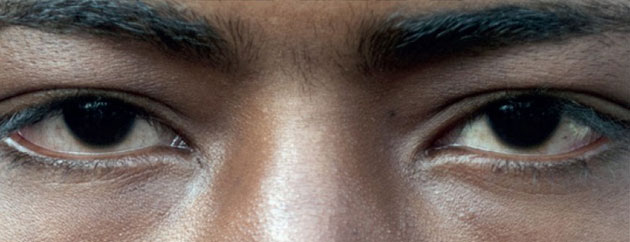
La Playa DC
30 July, 2012La Playa DC centres around a young person living in Bogotá, struggling to find a place for himself in the world amongst all the challenges which family life and a difficult economic situation can bring.
While this feeling is common to teenagers worldwide, Tomás’ past was caught up in problems more specific to Colombia: his family were forced to flee their home near the Pacific coast in Buenaventura after watching their father get killed by paramilitaries in the civil war.
Tomás (Luis Carlos Guevara) escapes the drudgery of his menial job by incessantly drawing and doodling with felt tips on every available surface. He wanders through the outskirts of the city to hike straight up into the luscious green mountains. Being somewhat steep and wild, they form both a continuation of and a contrast to the built up parts of the city. Comfortable in his solitude, his dreams start to take on a more solid form and we see him reflect on his mother telling him stories during his former life near the coast. While she braids his younger brother’s hair, she recounts that kids were once sent down mines with maps shaved into the backs of their heads so that everyone could find their way out again. These flashback sequences are accompanied by an ambient soundtrack with traditional folk music and female chanting in stark contrast to the daily life in Bogotá which is flanked by local hip hop, frantic street activity, racist attitudes and the constant threat of ‘random’ stop and search by the less-than-friendly police.
At the start of the film, Tomás’s brother Jairo (Andrés Murillo) has been missing for months and eventually turns up on his mother’s doorstep, seeking shelter. Everyone knows that he has been involved with drug gangs, and intimately more so with drugs specifically, but Tomás still wants his mother to give Jairo yet another chance. This is made more difficult by that universal problem of the evil stepdad who has little time for his adopted children and only cares about the safety of his new partner. Tomás quickly has enough and decides to go it alone by running away to find his way on the streets.
In some ways he is following in the footsteps of his older brother, Chaco (James Solis) who has been significantly independent for a while now:
“When I was your age I was already living on the streets, looking after myself.”
But despite owning some flashy hats and trainers and having spent some time in the USA, Chaco’s life has been a cycle of escape attempts: jumping on boats to Europe or across borders at night and when we meet him, he has just got out of prison. He clearly has no loyalty to where he lives and sees that his only chance at a life worth living will have to take place elsewhere:
“This fucking country. Every time I come back, I just want to leave again.”
And after an incident where the two brothers are thrown out of a mall, presumably for not being the right ethnicity, Chaco laments to his slightly naive sibling:
“All these years here and you still don’t realise that we’re the dogs!”
So Tomás goes along with this urge to escape for a while, helping Chaco clean car hubcaps to build up a pot of cash for the trip but the film really gets into its own when Tomás starts learning to cut hair.
Chaco notices that Tomás is an inspired, talented and prolific doodler and passes him on to a friend who runs a barbers, shaving the latest cool intricate designs into the scalps of eager customers. Everyone wants something fresh, unique and interesting to impress the ladies in the clubs and so there is a strange kind of art trade happening in the local economy with regular money to be made if you have the requisite skills.
It seems that Tomás does, and he starts to do well in his apprenticeship until old problems with his liability of a brother Jairo flare up again.
Ultimately, although it is put across rather subtly, La Playa DC shows the methods and merits of three different forms of escape from a bad situation, symbolised through the lives of each of the brothers. Chaco favours physically displacing himself at a chance for a better life somewhere more economically comfortable. Jairo escapes in a mental capacity with the help of narcotics:
“That’s what I like about this shit, it takes me out of this hole and back to Buevaventura.”
And eventually, more tragically, his ultimate release comes in death. At his wake, old women chant a traditional dirge full of symbolism about the release of the soul.
Tomás’ tale is the most interesting as he is still trying to find something which works for him. At first he gains some release through drawing, walking in the hills or chasing women. But after trying out both of his brothers’ methods he settles upon his own. By the end of the film he has started up a small but realistic chance at some economic independence which still retains aesthetic expression: cutting trendy designs into hair. This small victory shows that the grass is not necessarily greener elsewhere and transforms La Playa DC from a potentially bleak and difficult film into something more optimistic.
http://www.youtube.com/watch?v=swlB3Usv6DQ
Follow Sounds and Colours: Facebook / Twitter / Instagram / Mixcloud / Soundcloud / Bandcamp
Subscribe to the Sounds and Colours Newsletter for regular updates, news and competitions bringing the best of Latin American culture direct to your Inbox.

